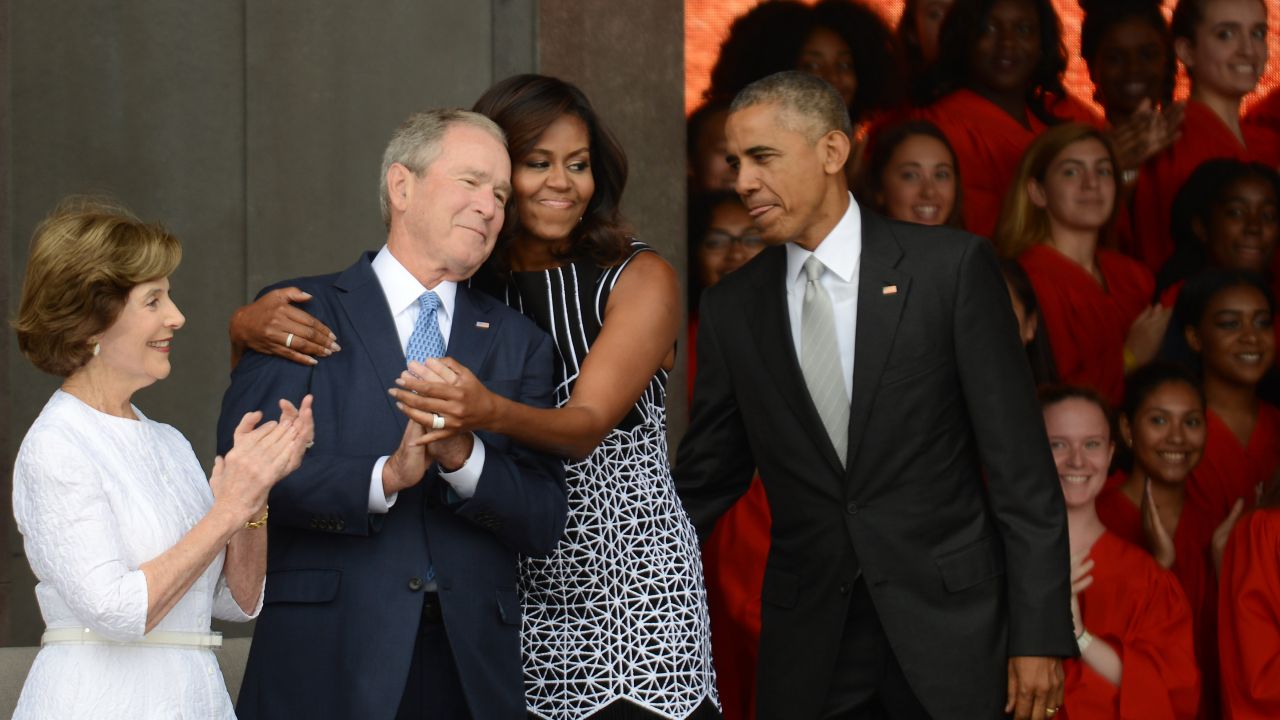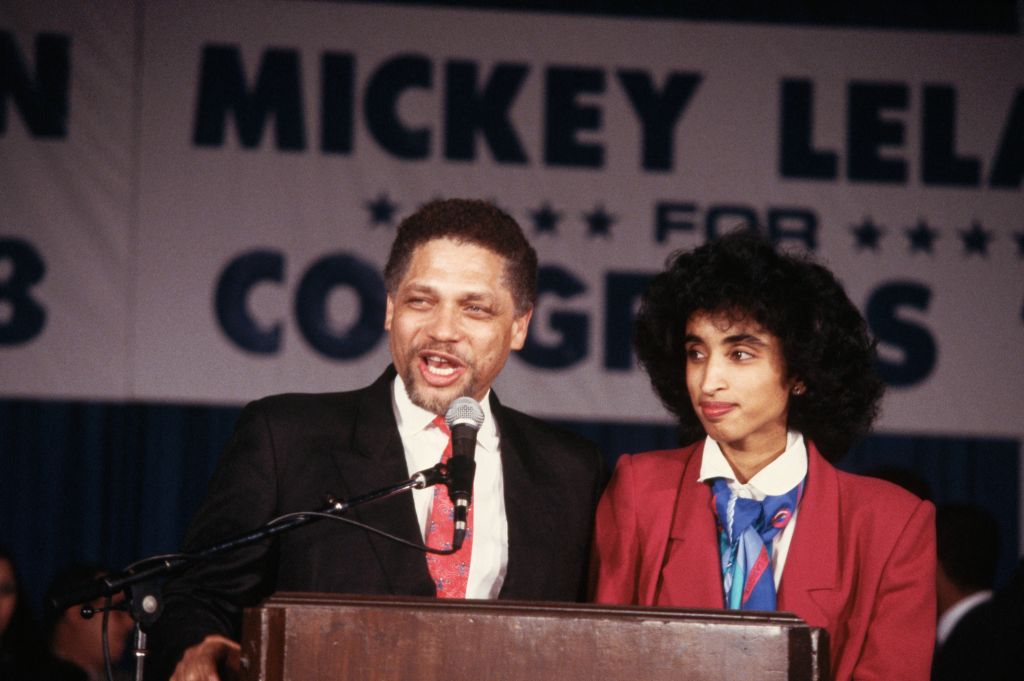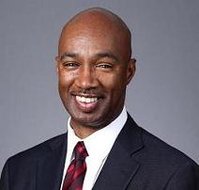
First lady Michelle Obama embraces former President George W. Bush, accompanied by his wife, former first lady Laura Bush, at the dedication of the National Museum of African American History and Culture in Washington, DC. (Photo by Astrid Riecken/Getty Images)
It was a joyous weekend in Washington and across the United States as the nation celebrated the opening of the National Museum of African American History and Culture. The celebration included current and former presidents, first ladies, members of Congress, civil rights icons, celebrities and tens of thousands of ordinary Americans of every hue.
But I couldn’t help but feel that one man was missing. For the last few months every time I drove or walked past the grounds of the new museum I thought about the late Rep. George T. “Mickey” Leland and how he would have reveled in delight if he had lived to see the museum opening.
Most people don’t know that Mickey — no one ever graced by his broad grin or mischievous personality ever would call him by a more formal title — lit the legislative spark that led to the museum. In 1986 he wrote and introduced legislation calling for the establishment of a Smithsonian museum about African-American life, culture and history.

Texas congressman Mickey Leland, joined by his wife Alison, speaks at a combined rally for his re-election campaign and Jesse Jackson’s 1988 presidential campaign. (Photo by Jacques M. Chenet/CORBIS/Corbis via Getty Images)
John Lewis, perhaps the greatest civil rights hero ever to serve in the US Congress, joined Mickey as a co-author of the legislation after he was elected in 1986. When Mickey died tragically in Ethiopia in 1989 trying to provide relief to victims of the famine, Lewis continued to carry the torch until the legislation was passed and the museum was established and built.
Mickey helped make some of the history the museum celebrates: One of the first black lawmakers in the Texas legislature, he succeeded Barbara Jordan in Congress when she retired from public life. He envisioned a museum that would speak honestly and provide the unvarnished truth about the black experience in America. His first bill would have established a National Museum on American Slavery. Mickey subsequently realized that such a museum would not be comprehensive enough, would not tell the complete story of the African-American experience in America. The story of black America has been as much about glory and victory as enslavement and degradation, so he amended his bill in later iterations to be inclusive of African-American history and culture more broadly.
Mickey understood and wanted whoever visited the museum to understand that the black American experience has been about more than slavery, and black Americans have been much more than slaves. We have been heroes and astronauts; entertainers and inventors; sports stars and surgeons; Pullman porters and fighter pilots. Mickey wanted a museum that would tell the totality of the black experience in America.
This museum does exactly that. It celebrates culture, cuisine and history, but it doesn’t whitewash history. It accurately depicts America’s struggles with its racial history, including segregation, Jim Crow and poll taxes. It helps you understand the pain of a mother watching her son die viciously at the hands of men who hated him for no reason other than the color of his skin.
The museum, importantly, also chronicles the struggle for civil rights, for human rights, for the right to be treated as equals in America.
Sadly, as we remember that racial past, we are still struggling to come to grips with race today.
One powerful exhibit at the museum is a statue of John Carlos and Tommie Smith giving the Black Power salute at the 1968 Olympics in Mexico City. Mickey died more than a quarter-century ago and would be astonished, yet proud, that in recent weeks, the Carlos/Smith protest has been adopted by thousands of black athletes and activists across the nation to protest continued racial injustice.
This week, even as I reflected on the joy Mickey would have felt upon the realization of the 100-year dream of establishing a museum about black Americans on the National Mall, the most prized ground in our nation’s capital, I know he would have felt the searing pain that so many Americans felt upon hearing news reports about shootings of black men in Tulsa and in Charlotte, North Carolina.
If Mickey were alive, he would be on the front lines of this more recent battle for justice. He would be appalled that a police officer in a helicopter above a stalled van called the driver of that van a “bad dude” for no reason other than his skin color and his size. He would be near tears watching a video of a wife pleading with the police not to kill her husband who had been sitting in his car before they arrived, threatening no one. He would have understood that the struggles so comprehensively and beautifully chronicled in the museum, continue today.
Last week was a week of great joy in America. As long as this nation stands there will be a place where people can come to understand and to celebrate the contributions of black Americans. Last week also was a week of great pain for many Americans, because more black families had to bury a son, a husband or a father killed by a police officer under questionable circumstances.
Joy and pain: two sides of the black experience. What could be more joyful than seeing our nation’s first black president join with a white president from Mickey’s home state of Texas to inaugurate a museum commemorating what it means to be black in America? And what could be more painful than knowing that in Tulsa, Oklahoma, and Charlotte, North Carolina, two more men who reportedly were committing no crimes died because of an encounter with police officers?
Mickey was someone who carried the dichotomy of the black experience with grace. He could be outraged without being angry; righteous without being resentful. Other than Hubert Humphrey, he was the happiest warrior in politics. And like the now-iconic embrace in which first lady Michelle Obama swept up former President George W. Bush at the museum opening, that capacity for joyful righteousness and happy outrage carried away even Mickey’s political opponents.
Former Rep. Jack Fields, who represented a neighboring Houston congressional district and who was as far to the right on the Republican spectrum as Mickey was to the left on the Democratic one, became a godfather to the Leland children and, after Mickey’s death, helped create the Leland Initiative in Africa to bring the Internet to the continent through USAID and to honor Mickey’s memory.
Mickey’s vision of a museum celebrating black life has been realized. His dream of a more equitable United States remains a work in progress. It’s a dichotomy and work that he would have embraced — and, knowing him, would have brought a few unlikely allies along for the ride. And that, like the history contained in a museum he helped create, is a legacy worth honoring.




